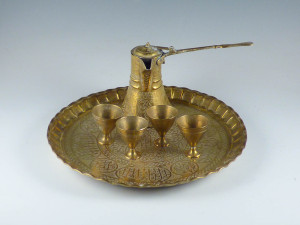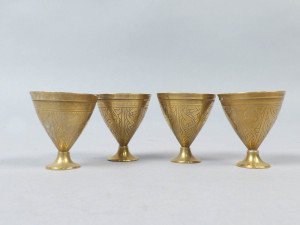 Over the past few years, Turkish coffee has grown in popularity in English-speaking countries due to its unique preparation process and flavor.
Over the past few years, Turkish coffee has grown in popularity in English-speaking countries due to its unique preparation process and flavor.
Recently we have had a few Turkish coffee sets come to us as estate finds, and we thought it would be interesting to shed some light on the culinary tradition of brewing Turkish coffee.
Turkish coffee is not an actual type of coffee -it is a preparation method, so there is no specific type of coffee bean used when preparing the drink. The process begins with a very finely ground coffee. Usually, grinding the coffee beans to a powder-like texture requires the use of a burr mill or a traditional Turkish hand grinder.
Next, heat water up on a stove in a cezve (Turkish coffee pot), bringing it to a brief boil before adding 1-2 heaping teaspoons of coffee (and as much sugar as desired) per serving he/she plans to make.
Once the coffee grounds sink to the bottom of the pot, the coffee maker can stir the mixture several times and put it over low heat. Some techniques advise coffee makers to remove the coffee from the heat, stir it, then boil it once or twice more. It should form a think froth or “kaimaki”. if the water boils too quickly, the coffee will lose much of its flavor and the foam will evaporate.
The foam is the key part of Turkish coffee, so serving the drink is more of an art form than part of a recipe. The goal of serving Turkish coffee is to get equal amounts of rich foam in each cup. The result is a frothy, strong cop of coffee that can be enjoyed with a dessert or any kind of treat.
 Though having your own vintage Turkish coffee set might excite those interested in antique cultural decor, there are certain precautions to take when actually preparing coffee in an older cezve.
Though having your own vintage Turkish coffee set might excite those interested in antique cultural decor, there are certain precautions to take when actually preparing coffee in an older cezve.
If a cezve is copper or brass like the one picttured from our inventory, it is always a good idea to check the inside of the pot to look for scratches. Only a cezve lined with unscratched tin are safe for brewing and serving.
There are many variations of coffee brewing that involve methods similar to Turkish coffee making, such as Greek coffee, Bosnian coffee, and Czech coffee. They all are all brewed in a slightly different manner, although they do all involve the main technique of pouring coffee directly into heated or boiling water to create a thick foam.
There are mystical factors that may play into Turkish coffee’s growing popularity in America; the grounds left after drinking the brew can be used for fortune telling. This type of fortune telling using coffee grounds or tea leaves is called tasseography. After the coffee drinker finishes his/her cup, the grounds can be dumped into a saucer, and the patterns can be examined to determine aspects of the drinker’s future.
Fantastic considerations aside, we think Turkish coffee is an excellent way to enjoy a strong brew, and with the impending fall weather approaching, Turkish coffee may be just what we need to stay toasty.
Take a look at our vintage Turkish coffee set here.
